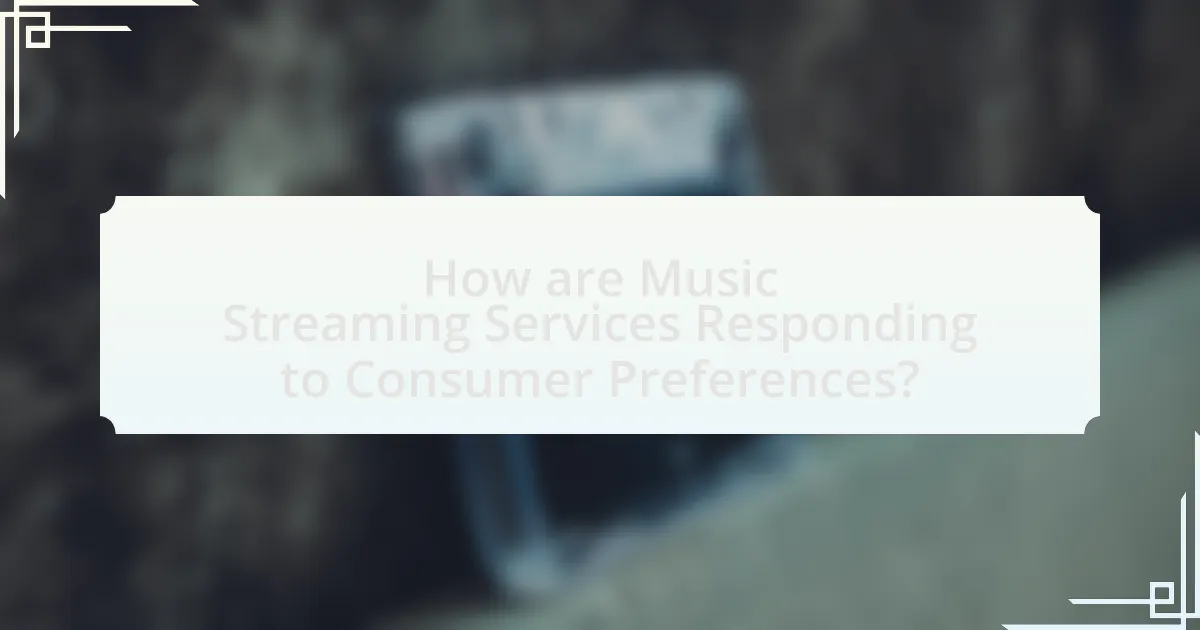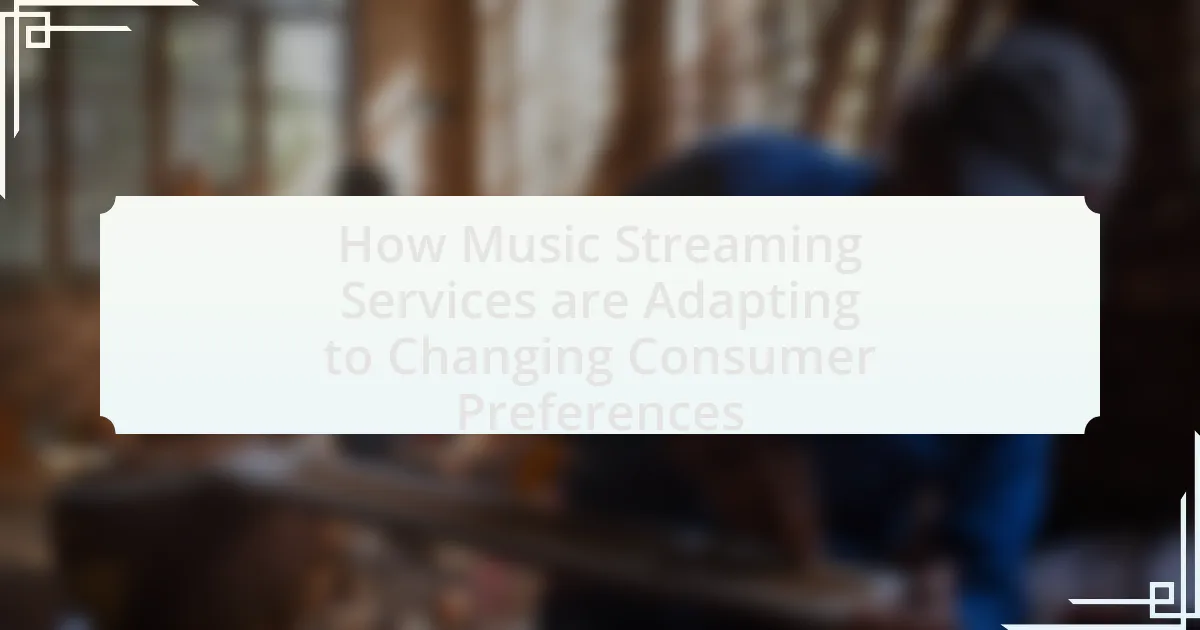Music streaming services are evolving in response to changing consumer preferences by enhancing personalization features, expanding content libraries, and introducing flexible subscription models. Key factors influencing these changes include technological advancements, demographic shifts, and the integration of social media, which collectively shape user engagement and content consumption. The article explores how algorithms improve user experience through tailored recommendations, the significance of curated playlists, and the impact of partnerships with artists and labels. Additionally, it examines emerging subscription models and the role of innovations in audio quality and user engagement strategies, highlighting the benefits for consumers in this dynamic landscape.

How are Music Streaming Services Responding to Consumer Preferences?
Music streaming services are responding to consumer preferences by enhancing personalization features, expanding content libraries, and offering flexible subscription models. For instance, platforms like Spotify and Apple Music utilize algorithms to curate personalized playlists based on user listening habits, which has been shown to increase user engagement and satisfaction. Additionally, services are broadening their offerings to include podcasts and exclusive content, catering to the growing demand for diverse audio experiences. According to a report by Statista, as of 2023, over 60% of users prefer platforms that provide a wide range of content beyond just music, indicating a shift in consumer expectations. Furthermore, many services are introducing tiered subscription plans, allowing users to choose options that best fit their budget and usage patterns, thus accommodating varying consumer needs.
What factors are influencing changes in consumer preferences for music streaming?
Changes in consumer preferences for music streaming are influenced by factors such as technological advancements, personalization, pricing models, and social media integration. Technological advancements, including improved internet speeds and mobile accessibility, have made streaming more convenient and appealing. Personalization through algorithms that recommend music based on listening habits enhances user experience, leading to increased engagement. Pricing models, such as subscription tiers and ad-supported options, cater to diverse consumer budgets, making services more accessible. Additionally, social media integration allows users to share music and discover new artists, further shaping their preferences. These factors collectively drive shifts in how consumers choose and engage with music streaming platforms.
How do demographic shifts impact music streaming preferences?
Demographic shifts significantly impact music streaming preferences by altering the types of music consumed and the platforms used. For instance, younger demographics, particularly Gen Z and Millennials, show a preference for platforms like TikTok and Spotify, favoring short-form content and personalized playlists. In contrast, older generations tend to gravitate towards traditional platforms such as YouTube and Apple Music, often seeking full albums and curated radio stations. According to a 2021 report by the International Federation of the Phonographic Industry (IFPI), 70% of Gen Z listeners prefer streaming services that offer personalized recommendations, highlighting how demographic characteristics shape user engagement and content consumption.
What role does technology play in shaping consumer behavior in music streaming?
Technology significantly influences consumer behavior in music streaming by enabling personalized experiences and enhancing accessibility. Streaming platforms utilize algorithms and data analytics to curate playlists and recommend songs based on individual listening habits, which increases user engagement and satisfaction. For instance, Spotify’s Discover Weekly feature uses machine learning to analyze user preferences, resulting in over 40 million users engaging with the feature weekly, demonstrating its impact on listening choices. Additionally, advancements in mobile technology and internet connectivity allow consumers to access music anytime and anywhere, further shaping their consumption patterns. This seamless access has led to a shift from ownership to access, with a reported 80% of music listeners preferring streaming services over purchasing music.
Why is personalization important in music streaming services?
Personalization is important in music streaming services because it enhances user engagement and satisfaction by delivering tailored content that aligns with individual preferences. This customization leads to increased listening time and user retention, as services like Spotify and Apple Music utilize algorithms to analyze user behavior, such as song skips and playlist additions, to curate personalized playlists and recommendations. Research indicates that personalized recommendations can boost user engagement by up to 30%, demonstrating the effectiveness of this approach in meeting changing consumer preferences in the music industry.
How do algorithms enhance user experience in music streaming?
Algorithms enhance user experience in music streaming by personalizing content recommendations based on user behavior and preferences. These algorithms analyze listening habits, song ratings, and user interactions to curate playlists and suggest new music that aligns with individual tastes. For instance, Spotify’s recommendation system utilizes collaborative filtering and natural language processing to deliver tailored playlists like Discover Weekly, which has been shown to increase user engagement and satisfaction. According to a study by the International Journal of Information Management, personalized recommendations can lead to a 30% increase in user retention rates, demonstrating the effectiveness of algorithms in enhancing the overall music streaming experience.
What are the benefits of curated playlists for consumers?
Curated playlists provide consumers with personalized music experiences that enhance their listening enjoyment. These playlists are often tailored to individual tastes, moods, or activities, making it easier for users to discover new music that aligns with their preferences. Research indicates that 70% of listeners prefer curated playlists over traditional radio, as they offer a more relevant and engaging selection of songs. Additionally, curated playlists save time for consumers by eliminating the need to search for music, allowing them to enjoy a seamless listening experience.
How are music streaming services adapting their business models?
Music streaming services are adapting their business models by diversifying revenue streams and enhancing user engagement. For instance, platforms like Spotify and Apple Music are increasingly offering exclusive content, such as original podcasts and artist collaborations, to attract and retain subscribers. Additionally, they are implementing tiered subscription models that provide users with options ranging from ad-supported free access to premium ad-free experiences, catering to varying consumer preferences. According to a report by the International Federation of the Phonographic Industry (IFPI), 2022 saw a 21% increase in paid subscriptions, indicating a shift towards premium offerings. This adaptation reflects a strategic response to changing consumer behaviors and preferences for personalized and exclusive content.
What subscription models are emerging in the music streaming industry?
Emerging subscription models in the music streaming industry include tiered pricing, family plans, and bundled services. Tiered pricing allows users to choose from multiple subscription levels, each offering different features such as audio quality or exclusive content, catering to diverse consumer preferences. Family plans enable multiple users to share a single subscription at a discounted rate, appealing to households. Bundled services combine music streaming with other digital services, such as video streaming or gaming, enhancing value for consumers. These models reflect the industry’s response to changing consumer demands for flexibility and value.
How do partnerships with artists and labels influence service offerings?
Partnerships with artists and labels significantly influence service offerings by enabling music streaming platforms to provide exclusive content, curated playlists, and promotional events. These collaborations allow services to differentiate themselves in a competitive market, as seen with Spotify’s exclusive podcast deals and Apple Music’s artist-led initiatives. For instance, exclusive album releases or live-streamed concerts can attract subscribers and enhance user engagement, directly impacting subscription growth and retention rates. Additionally, partnerships often lead to tailored marketing strategies that resonate with specific fan bases, further solidifying the platform’s appeal and relevance in a rapidly evolving industry.

What trends are shaping the future of music streaming services?
The future of music streaming services is being shaped by personalization, integration of social features, and the rise of audio content beyond music. Personalization is increasingly important, with algorithms that curate playlists based on user behavior; for instance, Spotify’s Discover Weekly feature has significantly enhanced user engagement by providing tailored music recommendations. Integration of social features allows users to share music and playlists, fostering community and interaction, as seen with platforms like TikTok driving music discovery through user-generated content. Additionally, the rise of podcasts and audiobooks within streaming platforms reflects a shift towards diverse audio content consumption, with services like Apple Music and Spotify expanding their offerings to include these formats, catering to a broader audience and changing listening habits.
How is the rise of social media affecting music streaming consumption?
The rise of social media is significantly increasing music streaming consumption by enhancing music discovery and engagement. Platforms like TikTok and Instagram allow users to share snippets of songs, leading to viral trends that drive listeners to streaming services. For instance, a study by the International Federation of the Phonographic Industry (IFPI) in 2021 found that 70% of users discover new music through social media, which directly correlates with increased streaming activity on platforms like Spotify and Apple Music. This interconnectedness between social media and music streaming creates a feedback loop where popular tracks gain traction, resulting in higher streaming numbers and broader audience reach.
What impact do viral trends have on music streaming platforms?
Viral trends significantly boost user engagement and streaming numbers on music platforms. When a song or artist goes viral, it often leads to increased visibility and plays, as seen with tracks like “Old Town Road” by Lil Nas X, which gained immense popularity through social media platforms like TikTok. This surge in interest can result in higher chart positions, more playlist placements, and ultimately, increased revenue for both the streaming service and the artists involved. Additionally, music streaming platforms adapt their algorithms to promote trending songs, further amplifying their reach and impact.
How are user-generated content and sharing features changing the landscape?
User-generated content and sharing features are transforming the music streaming landscape by enhancing user engagement and fostering community interaction. Platforms like TikTok and Instagram have demonstrated that user-generated content can drive music discovery and virality, with 67% of users reporting that they discover new music through social media. Additionally, sharing features allow users to create playlists collaboratively, promoting a sense of ownership and personalization in their listening experience. This shift towards user-centric models is evident as streaming services increasingly integrate social features, leading to higher user retention and satisfaction.
What innovations are being introduced in music streaming technology?
Innovations in music streaming technology include the integration of artificial intelligence for personalized recommendations, enhanced audio quality through lossless streaming, and the introduction of spatial audio formats. These advancements allow platforms to tailor user experiences more effectively, ensuring that listeners receive music suggestions based on their unique preferences and listening habits. For instance, Spotify’s AI-driven algorithms analyze user behavior to curate playlists, while Tidal offers lossless audio streaming, appealing to audiophiles seeking superior sound quality. Additionally, Apple Music’s adoption of spatial audio creates an immersive listening experience, reflecting the industry’s shift towards more engaging and high-fidelity content.
How is artificial intelligence transforming music recommendations?
Artificial intelligence is transforming music recommendations by utilizing algorithms that analyze user behavior, preferences, and listening patterns to deliver personalized content. These AI-driven systems, such as those used by Spotify and Apple Music, leverage vast amounts of data to identify trends and suggest songs that align with individual tastes. For instance, Spotify’s recommendation engine employs collaborative filtering and natural language processing to curate playlists like Discover Weekly, which has been shown to increase user engagement by 40% according to internal metrics. This data-driven approach not only enhances user satisfaction but also helps streaming services retain subscribers in a competitive market.
What advancements in audio quality are being prioritized by streaming services?
Streaming services are prioritizing advancements in high-resolution audio formats, spatial audio, and lossless streaming to enhance audio quality. High-resolution audio formats, such as FLAC and MQA, provide greater detail and clarity compared to standard formats, appealing to audiophiles. Spatial audio technologies, like Dolby Atmos, create immersive listening experiences by simulating a three-dimensional sound environment. Additionally, lossless streaming options, offered by platforms like Tidal and Apple Music, allow users to enjoy music without any compression artifacts, ensuring the highest fidelity. These advancements reflect the industry’s response to consumer demand for superior audio experiences.
Why is user engagement critical for the success of music streaming services?
User engagement is critical for the success of music streaming services because it directly influences subscriber retention and revenue generation. High levels of user engagement lead to increased listening time, which enhances the likelihood of users maintaining their subscriptions. According to a report by Deloitte, engaged users are 50% more likely to remain subscribed to a service, thereby reducing churn rates. Additionally, user engagement drives personalized recommendations and content discovery, which are essential for enhancing user satisfaction and loyalty. This cycle of engagement, retention, and satisfaction ultimately contributes to the financial viability and growth of music streaming platforms.
How do interactive features enhance user retention in music streaming?
Interactive features enhance user retention in music streaming by fostering engagement and personalization. These features, such as playlists curated by users, social sharing options, and real-time feedback mechanisms, create a more immersive experience that encourages users to return. For instance, a study by Midia Research found that platforms offering personalized playlists and social interaction saw a 30% increase in user retention rates compared to those without such features. This indicates that when users feel a sense of ownership and community, they are more likely to remain loyal to the service.
What strategies are being employed to increase user loyalty?
Music streaming services are employing personalized recommendations and exclusive content to increase user loyalty. By utilizing algorithms that analyze user behavior and preferences, these platforms can curate playlists and suggest songs tailored to individual tastes, enhancing user engagement. Additionally, offering exclusive releases, artist interviews, and live-streamed events fosters a sense of community and belonging among users. For instance, Spotify’s “Discover Weekly” feature has been shown to significantly boost user retention rates, as it provides a unique listening experience that keeps subscribers returning.

How can consumers benefit from the evolving music streaming landscape?
Consumers can benefit from the evolving music streaming landscape through increased access to diverse music libraries, personalized recommendations, and enhanced user experiences. As streaming services expand their catalogs, users gain access to millions of songs across various genres and artists, which was not as readily available in traditional formats. Additionally, advancements in algorithms allow for tailored playlists and suggestions based on listening habits, making music discovery more efficient and enjoyable. For instance, Spotify reported that over 30% of its users discover new music through personalized playlists, showcasing the effectiveness of these recommendations. Furthermore, the competitive nature of the streaming market drives services to innovate, leading to features like high-definition audio and exclusive content, which further enrich the consumer experience.
What are the best practices for maximizing the use of music streaming services?
To maximize the use of music streaming services, users should create personalized playlists, explore curated content, and utilize offline listening features. Personalized playlists enhance user experience by tailoring music selections to individual tastes, which is supported by data showing that users who engage with personalized content spend 30% more time on platforms. Exploring curated content, such as playlists created by music experts or algorithms, allows users to discover new artists and genres, increasing overall satisfaction and engagement. Additionally, utilizing offline listening features enables users to enjoy music without relying on internet connectivity, making it convenient for various situations, such as traveling or in areas with poor service.
How can users discover new music effectively on streaming platforms?
Users can discover new music effectively on streaming platforms by utilizing personalized playlists, algorithm-driven recommendations, and curated content. Streaming services like Spotify and Apple Music employ sophisticated algorithms that analyze user listening habits to suggest songs and artists tailored to individual preferences. For instance, Spotify’s “Discover Weekly” playlist updates every week based on users’ listening history, introducing them to tracks they are likely to enjoy. Additionally, users can explore genre-specific playlists and follow artists to receive updates on new releases, further enhancing their music discovery experience.
What tips can enhance the overall listening experience for consumers?
To enhance the overall listening experience for consumers, utilizing high-quality audio formats is essential. High-resolution audio files, such as FLAC or ALAC, provide superior sound quality compared to standard MP3 files, allowing listeners to experience music as intended by the artists. Additionally, creating personalized playlists based on listening habits can significantly improve user engagement and satisfaction. Research indicates that personalized recommendations increase user retention rates by up to 30%, as consumers feel more connected to the music they enjoy. Furthermore, incorporating features like offline listening and customizable equalizers allows users to tailor their experience to their preferences, making it more enjoyable and accessible.
How do changing consumer preferences influence music discovery?
Changing consumer preferences significantly influence music discovery by shifting the focus towards personalized and algorithm-driven recommendations. As listeners increasingly favor curated playlists and tailored suggestions, music streaming services like Spotify and Apple Music adapt their algorithms to analyze user behavior, preferences, and listening history. This data-driven approach enhances the discovery process, allowing users to find new artists and genres that align with their tastes. For instance, Spotify’s “Discover Weekly” playlist utilizes machine learning to provide users with a weekly selection of songs based on their listening habits, demonstrating how consumer preferences directly shape the tools and features offered for music discovery.
What role do recommendations play in helping users find new artists?
Recommendations play a crucial role in helping users discover new artists by personalizing the listening experience based on individual preferences and listening habits. Music streaming services utilize algorithms that analyze user data, such as previously listened tracks and user-generated playlists, to suggest artists that align with a listener’s tastes. For instance, Spotify’s Discover Weekly feature curates a personalized playlist each week, introducing users to new artists they are likely to enjoy, which has been shown to increase user engagement and satisfaction. This targeted approach not only enhances user experience but also supports emerging artists by providing them with visibility to potential fans who may not have found them otherwise.
How can playlists be utilized for better music exploration?
Playlists can be utilized for better music exploration by curating diverse selections that introduce listeners to new genres, artists, and songs. Music streaming services like Spotify and Apple Music leverage algorithms to create personalized playlists based on user listening habits, which enhances discovery. For instance, Spotify’s “Discover Weekly” playlist analyzes a user’s past listening patterns and suggests tracks that align with their tastes, leading to the exploration of unfamiliar music. This method not only broadens musical horizons but also increases user engagement, as studies show that personalized recommendations can boost listening time by up to 30%.

Leave a Reply